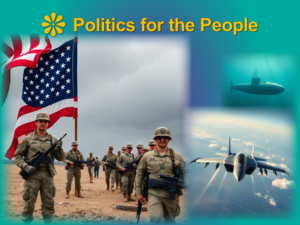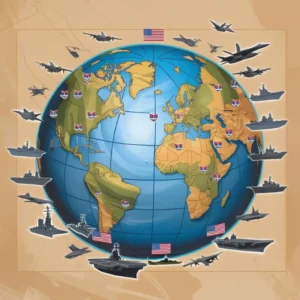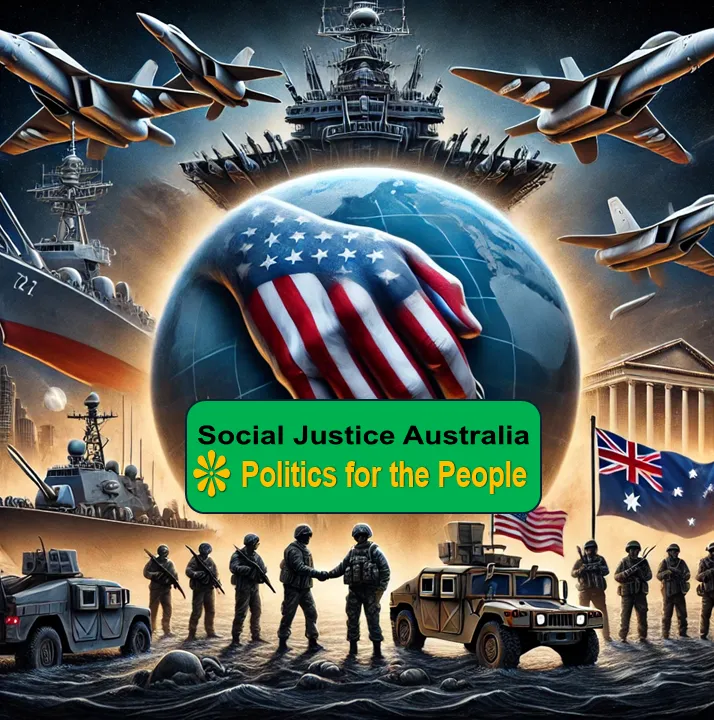Description
Discover how USAs endless wars destabilise nations and why Australia’s alignment with the US military threatens its sovereignty and security.
Introduction

For over a century, the United States has engaged in military interventions worldwide, often framed as efforts to spread democracy and protect human rights. However, history shows these interventions have frequently served corporate interests, ideological dominance, and geopolitical strategies rather than humanitarian concerns.
From orchestrating coups to funding proxy wars and setting up military bases across the globe, US actions have led to mass displacement, economic turmoil, and loss of sovereignty in many nations. Australia’s increasing alignment with the US military brings significant risks, potentially compromising national security and financial independence.
This article examines the history of US interventions, their consequences, and why Australia must develop an independent foreign policy free from US influence.
The Foundation of US Imperialism
Colonial Expansion and the Displacement of Indigenous Peoples
• The forced removal of Indigenous nations from their lands in North America.
• The Indian Removal Act (1830) and the reservation system.
• The Doctrine of Manifest Destiny and its role in territorial expansion.
The Spanish-American War and US Global Influence
• Five consecutive US Presidents tried to purchase Cuba before the Spanish-American War (1898).
• The US’s occupation of Cuba, Puerto Rico, Guam, and the Philippines.
• The Platt Amendment (1901) and its impact on Cuban sovereignty.
The Panama Canal and US Control Over Latin America
• The US-backed Panama’s independence from Colombia (1903).
• The strategic and economic importance of the Panama Canal.
• The long-term consequences of US interference in Panamanian affairs.
Military Interventions for Economic and Geopolitical Gain
Nicaragua, Haiti, and Central America (1910-1934)
• The repeated US military interventions in Nicaragua to protect business interests.
• The occupation of Haiti (1915-1934) to secure American corporate dominance.
• The long-term economic dependency created by these interventions.
US Corporate Interests and Nazi Germany
• The role of Ford, IBM, and Standard Oil in financing Nazi Germany (1920s-1930s). Ref: https://www.gilderlehrman.org/sites/default/files/file_media/37_Murphy.pdf
• How American corporations helped Germany circumvent Treaty of Versailles restrictions.
• The Ratlines network that enabled Nazi war criminals to escape to South America and the Middle East. Ref: https://coffeeordie.com/nazi-ratlines
The Korean War: US Expansion Beyond the 38th Parallel
• The US’s push into North Korea (1950) and China’s subsequent intervention.
• The Korean War’s impact on global politics and the ongoing division of Korea.
Regime Change and Proxy Wars in the Cold War Era
Iran (1953) – The Overthrow of Mossadegh
• Iran’s nationalisation of the oil industry and the US-UK response.
• The CIA-led coup against Mossadegh and the installation of the Shah of Iran.
• The Shah’s rule as a US ally until the 1979 revolution.
US-Backed Coups in Latin America
• Guatemala (1954): Overthrow of Jacobo Árbenz to protect United Fruit Company.
• Operation Condor (1975-1989): US-backed military dictatorships in Argentina, Chile, and Brazil.
• The 1989 Panama invasion and removal of Manuel Noriega.
The Vietnam War: A 30-Year US Military Disaster
• US support for French colonialism (1945-1954) and direct military involvement.
• The impact of Agent Orange, massacres, and civilian deaths.
• How Vietnam’s resistance shaped modern anti-imperialism.
The Post-Cold War Era and US Hegemony
The Gulf War (1990) – Protecting Oil Interests
• Iraq’s invasion of Kuwait and the US-led military response.
• The US’s real motives in securing oil control in the Middle East.
The War on Terror: Afghanistan and Iraq (2001-2003)
• The 9/11 attacks and the invasion of Afghanistan.
• The false claims of Weapons of Mass Destruction (WMDs) in Iraq.
• The consequences: Civilian casualties, sectarian violence, and the rise of ISIS.
The US Military Empire – 800 Bases Worldwide

• The strategic placement of US military bases.
• The political, economic, and environmental consequences of US military expansion.
The Dangers of Australia Aligning with the US Military
Loss of Australian Sovereignty
• The increasing military integration between Australia and the US, including bases and joint operations.
• The AUKUS agreement and its implications for Australian independence.
Increased Risk of Conflict
• Australia’s involvement in US-led wars in Iraq and Afghanistan, despite no direct national security threat.
• Potential entanglements in US-China tensions and future conflicts in the Indo-Pacific.
Economic and Social Costs
• Military spending redirected toward US-led initiatives rather than domestic priorities.
• The risk of Australia becoming a target in global conflicts due to its close military ties with the US.
Conclusion
The history of US military interventions reveals a troubling pattern of aggression, economic exploitation, and geopolitical dominance that has left lasting scars on the global landscape. From Latin America to the Middle East, US foreign policy has led to the deaths of millions, widespread displacement, and long-term economic and political instability. The justification of these interventions under the pretence of spreading democracy often masks the pursuit of corporate and strategic interests, which ultimately benefit a select few while devastating entire nations.
The consequences of these interventions extend beyond the targeted nations. The ripple effects of war, economic sanctions, and regime change operations contribute to global insecurity, increasing the likelihood of terrorism, refugee crises, and diplomatic tensions. The financial burden of war also reinforces a system where military-industrial interests take precedence over human rights, environmental sustainability, and global cooperation.
For Australia, continued alignment with US military strategies poses significant risks. By participating in US-led wars, maintaining military bases, and deepening its commitment to the AUKUS agreement, Australia risks being drawn into unnecessary conflicts that do not serve its national interests. Moreover, prioritising militarism over diplomacy diminishes Australia’s ability to foster independent international relationships, negotiate trade agreements on its own terms, and establish a sovereign defence strategy that prioritises regional stability over foreign interventions.
To protect its sovereignty and long-term security, Australia must adopt a foreign policy that prioritises diplomacy, peace-building, and multilateral cooperation rather than blindly following US military agendas. A truly independent approach would involve reassessing military alliances, reducing foreign troop presence, and focusing on strengthening regional partnerships, particularly within the Indo-Pacific, to ensure a more balanced and peaceful international order. Australia has the resources, economic power, and global standing to lead by example—choosing peace over war, cooperation over subservience, and true independence over external influence.
Q&A Section
Q: Why does the US engage in so many military interventions?
A: The US claims to promote democracy and security, but many interventions serve corporate and geopolitical interests.
Q: How do US interventions affect global stability?
A: US-led wars and regime changes create long-term instability, economic hardship, and displacement.
Q: How can Australia reduce its dependence on US foreign policy?
A: By prioritising diplomacy over military alliances, investing in sovereign defence, and using monetary sovereignty to foster independence.
Call to Action
Do you see opportunities for community-driven change in Australia’s dollar sovereignty?
If you found this article insightful, explore more about political reform and Australia’s monetary sovereignty on Social Justice Australia: https://socialjusticeaustralia.com.au/
Share this article with your community to help drive the conversation toward a more just and equal society.
Click on our “Reader Feedback”. Please let us know how our content has inspired you. Submit your testimonial and help shape the conversation today!
Additionally, leave a comment about this article below.
Support Social Justice Australia – Help Keep This Platform Running
Social Justice Australia is committed to delivering independent, in-depth analysis of critical issues affecting Australians. Unlike corporate-backed media, we rely on our readers to sustain this platform.
If you find value in our content, consider making a small donation to help cover the costs of hosting, maintenance, and continued research. No matter how small, every contribution makes a real difference in keeping this site accessible and ad-free.
💡 Your support helps:
✅ Keep this website running without corporate influence
✅ Fund research and publishing of articles that challenge the status quo
✅ Expand awareness of policies that affect everyday Australians
💰 A one-time or monthly donation ensures Social Justice Australia stays a strong, independent voice.
🔗 Donate Now
Thank you for being part of this movement for change. Your support is truly appreciated!

